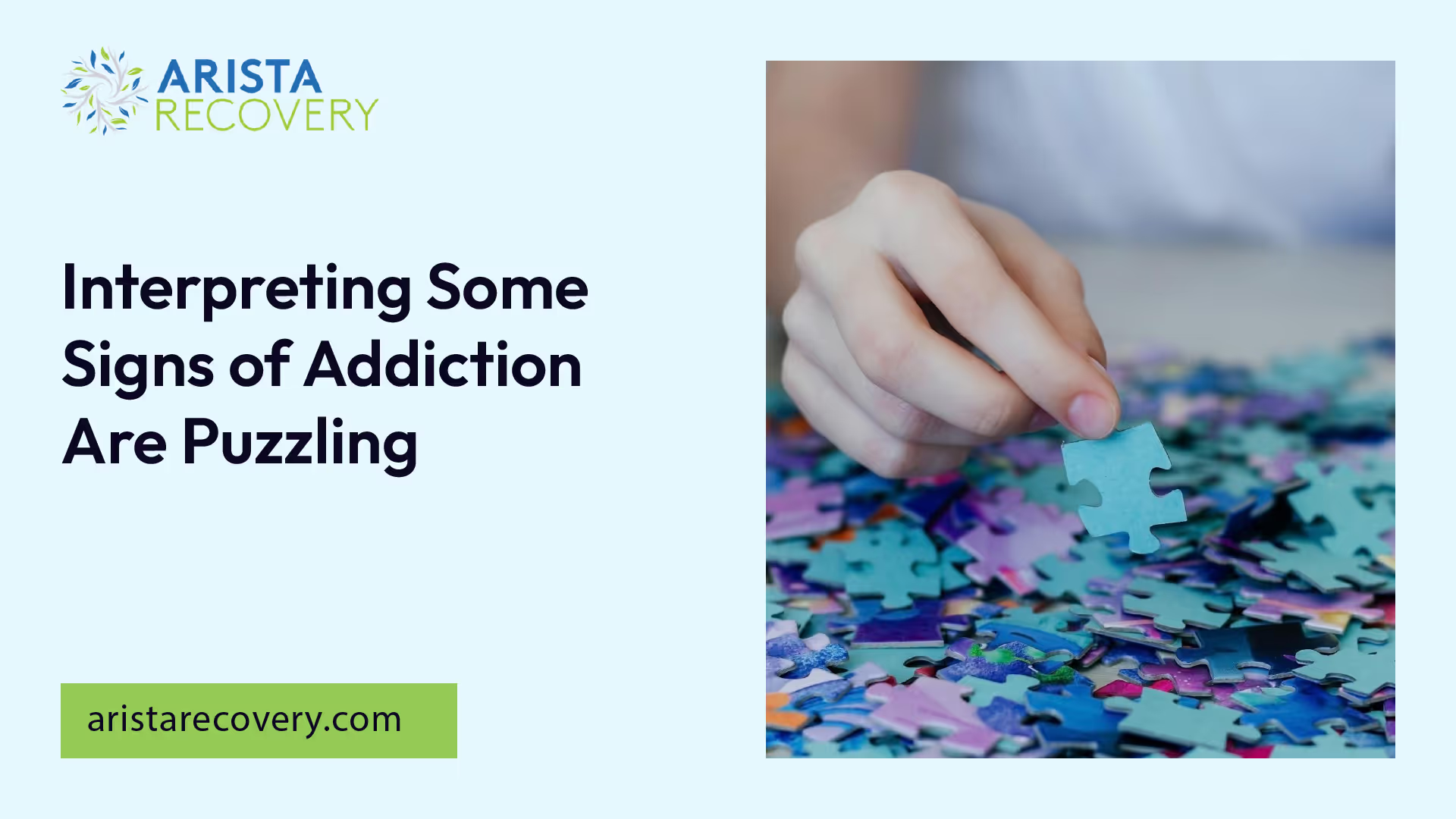Interpreting Some Signs of Addiction Are Puzzling


Understanding Addiction
Definition of Addiction
Addiction is a complex, chronic brain disorder characterized by compulsive substance use or engagement in certain behaviors. It necessitates understanding and support, as it is not simply a matter of willpower or moral weakness [1]. Addiction affects both the brain and behavior, leading to a compulsive need to use drugs or alcohol or to engage in activities like gambling or gaming. This behavior is driven by significant alterations in the brain's reward system, arising from an overpowering desire for the addictive substance or behavior.
Complex Nature of Addiction
The complexity of addiction arises from various contributing factors, including genetic predisposition, environmental influences, and psychological aspects.
This interplay of genetic, environmental, and psychological factors contributes to the intricate nature of addiction. Changes in personality and behavior serve as early clues for recognizing addiction, including secretiveness, sudden shifts in activity patterns, and neglecting personal appearance [2]. Awareness of these signs is essential for understanding the complexities of addiction and facilitating early intervention.
Recognizing Signs of Addiction
When navigating the complex landscape of addiction, recognizing the signs can be challenging. Some signs of addiction are puzzling and may not be immediately obvious. This section outlines key indicators to assist in identifying potential addiction.
Behavioral Changes
Behavioral changes are often key indicators of addiction. These changes may vary in severity, but the presence of multiple alterations should raise concerns and prompt further investigation. Common behavioral signs include:
These signs indicate that the individual may be prioritizing their substance use over other aspects of their life.
Social Withdrawal
Isolation and alienation are common effects of addiction. Individuals may distance themselves from friends, family, and social activities they once enjoyed. This withdrawal can manifest in various ways, including:
Addiction profoundly alters one's prioritization of relationships, often causing them to minimize contact with loved ones.
Manipulative Behaviors
Manipulative behaviors may surface as individuals attempt to maintain their substance use while minimizing the impact on their relationships. Such behaviors can include:
These tactics demonstrate an effort to sustain their addiction while avoiding confrontation or accountability [4].
Understanding these signs can enable friends and family to provide support and encourage individuals struggling with addiction to seek help. Acknowledging puzzling behaviors is the first step in addressing this challenging issue.
Common Signs of Addiction
Identifying addiction can be challenging, as some signs of addiction are puzzling. Recognizing these signs can aid in understanding the condition and seeking appropriate help. Below are some common indicators of addiction.
Changes in Physical Appearance
Addiction often leads to noticeable changes in an individual's physical appearance. These changes can be alarming and may include:
Physical ChangeDescriptionWeight FluctuationsIndividuals may experience significant weight loss or gain due to poor eating habits or neglect of self-care.Poor HygieneNeglecting basic grooming and hygiene routines becomes common as the addiction takes precedence.Change in SkinSkin conditions, including acne, bruises, or sores, may appear due to substance abuse.Dilated or Constricted PupilsThe size of pupils can change based on substance use, indicating possible addiction.
Disruptions in brain chemistry due to addiction can lead to prioritizing substance use over personal health and care [3].
Isolation and Secretive Behavior
Social isolation is another prevalent sign of addiction. Individuals may withdraw from friends and family, choosing to spend time alone or with others who enable their addiction. The following behaviors may be observed:
BehaviorDescriptionAvoiding Social InteractionsIndividuals may stop attending gatherings or meeting friends they once enjoyed.Secretive ActionsEngaging in behaviors that require secrecy, such as hiding substances or lying about whereabouts.AlienationFeelings of alienation from loved ones increase, as the individual prioritizes their substance over relationships.
Isolation and alienation can cause strain and tension in relationships, eroding trust.
Increased Risk-Taking
As addiction progresses, individuals may engage in increasingly risky behaviors. This change can manifest in several ways, including:
Risky BehaviorDescriptionDriving Under the InfluenceIndividuals may drive while impaired, endangering themselves and others.Financial MismanagementSpending significant amounts of money on substances without concern for financial responsibilities.Dangerous SituationsEngaging in illegal activities or associating with dangerous individuals to obtain substances.
The need to satisfy the overwhelming desire for the substance may overshadow the individual's judgment, leading to actions that compromise their safety and well-being [3].
Recognizing these signs is crucial for identifying potential addiction in oneself or others. Awareness can encourage individuals to seek support and intervention, ultimately leading to recovery.
Types of Addictions
Understanding the various types of substance addictions can help identify symptoms and seek appropriate help. This section covers some of the most common forms of addiction, including alcohol use disorder, opioid addiction, and benzodiazepine abuse.
Alcohol Use Disorder
Estimated at around 17 million adults aged 18 and older in the United States, alcohol use disorder (AUD) is a significant public health concern [5]. Despite alcohol being a legal intoxicating substance for individuals over the age of 21, its misuse can lead to severe consequences.
StatisticValueAdults with AUD17 millionLegal drinking age21 years
Some puzzling signs of addiction may include changes in social circles, new habits, or secrecy related to alcohol consumption [6].
Opioid Addiction
Opioid addiction has become an epidemic in the United States, affecting countless individuals. Many who can no longer access prescribed opiates may turn to illicit drugs such as heroin or fentanyl. This shift in substance use has resulted in thousands of overdose deaths nationwide [5].
StatisticValueOpioid-related overdose deathsThousands annually
Recognizing the signs of opioid addiction is crucial, as it can lead to severe health outcomes and even fatalities.
Benzodiazepine Abuse
Addiction to benzodiazepines is increasingly common. In 2013, it was reported that 30% of overdose deaths involved benzodiazepines like Klonopin, Xanax, or Valium, either alone or in combination with other substances [5]. These medications are often prescribed for anxiety or sleep disorders, but their misuse can lead to significant health hazards.
StatisticValueOverdose deaths with benzodiazepines30% of total overdose deaths (2013)
Stand-alone signs of addiction may include secrecy about usage and changes in routine or relationships.
Understanding these addiction types is vital to recognizing when help is needed. The signs can be puzzling, requiring careful attention to behavioral changes and lifestyle alterations that may indicate deeper issues.
Impact of Addiction
Addiction has far-reaching effects that impact an individual's health as well as their social relationships. Recognizing these consequences is crucial for understanding the full scope of the issue.
Health Consequences
Addiction can lead to a range of serious health issues, both physically and mentally. The condition causes profound changes in the brain's reward system, disrupting its normal functioning and altering brain chemistry. This alteration can compel individuals to prioritize obtaining and using the substance over other vital aspects of life [3].
Below is a table illustrating some common health effects associated with various types of addiction:
Health EffectsDescriptionWeight lossSignificant and rapid weight fluctuationsPoor hygieneNeglect of personal care and groomingNeglect of physical appearanceDisinterest in how one looksOrgan damageDamage to vital organs, especially the liver, heart, and lungsCompromised immune functionIncreased susceptibility to infectionsIncreased risk of chronic diseasesConditions such as diabetes, heart disease, and others
With long-term addiction, individuals often experience mental health challenges, including mood disorders, anxiety, and depression. As the brain's reward circuitry is hijacked, there is a reduced response to natural rewards, creating an overwhelming craving for the addictive substance.
Social and Relationship Effects
The social implications of addiction are equally significant. Individuals struggling with addiction may become isolated and alienated from friends and family. Relationships can suffer due to manipulation and deception, creating strain and tension in personal connections [3]. The erosion of trust can further complicate relationships, leading to rupture and discord.
The following table summarizes key social and relational effects of addiction:
Social EffectsDescriptionIsolationWithdrawal from social interactions and activitiesAlienationFeeling disconnected from family and friendsManipulative behaviorsLying or deceiving others to hide addictionErosion of trustDifficulty in maintaining healthy relationshipsFinancial instabilityEconomic distress due to spending on substances
In summary, addiction does not only impact the individual experiencing it; it also severely affects those around them. Understanding these complexities may help in addressing the signs of addiction that may seem puzzling to those observing the behaviors of their loved ones.
Seeking Help and Treatment
When addressing addiction, it is crucial to seek help and explore treatment options. Each individual may respond differently to treatment, and a combination of approaches is often most effective. The primary methods of assistance include the detoxification process, behavioral counseling, and various support and recovery options.
Detoxification Process
Detoxification is a critical initial step in the treatment of addiction. It is aimed at managing acute withdrawal symptoms that occur when a person stops using drugs or alcohol. This process prepares individuals for further treatment and therapy.
Key Functions of DetoxificationManages withdrawal symptomsStabilizes physical healthPrepares individuals for ongoing therapy
The detoxification process is essential because it fosters a safer environment for individuals to overcome the immediate physical aspects of addiction. This stage addresses both the physical dependency on substances and the preparation for more comprehensive treatments.
Behavioral Counseling
Behavioral counseling is a significant treatment option that addresses the psychological and behavioral aspects of addiction. This form of therapy helps individuals identify triggers, develop coping strategies, and modify the behaviors that sustain their addiction.
Benefits of Behavioral CounselingIdentifies and addresses underlying issuesTeaches coping mechanismsReduces the likelihood of relapse
Counseling can involve various formats, including individual, group, or family therapy. It plays a vital role in promoting lasting recovery and addressing the emotional challenges associated with addiction.
Support and Recovery Options
Support and recovery options form a critical component of an individual's journey toward recovery. Various resources available include support groups, rehabilitation programs, and aftercare services. These options provide ongoing assistance post-treatment:
Types of Support and Recovery OptionsSupport Groups (e.g., AA, NA)Inpatient RehabilitationOutpatient RehabilitationAftercare Programs
Participating in support services allows individuals to connect with others facing similar challenges. These support networks offer encouragement and shared experiences, which can be instrumental in maintaining sobriety. Seeking help through detoxification and behavioral counseling is essential for effectively combating addiction and promoting sustainable recovery.
References
[2]:
[3]:
[4]:
[5]:
[6]:
[7]:
You’re not alone in this.
When mental health challenges and addiction intersect, it can feel isolating. At Arista, we offer compassionate, evidence-based, and trauma-informed care to help you heal, grow, and move forward.
You’re not alone in this.
When mental health challenges and addiction intersect, it can feel isolating. At Arista, we offer compassionate, evidence-based, and trauma-informed care to help you heal, grow, and move forward.
Support that moves with you.
You’ve taken a brave first step. At Arista Recovery, we’re here to help you continue with best-in-class care designed for long-term healing and support.
.webp)






